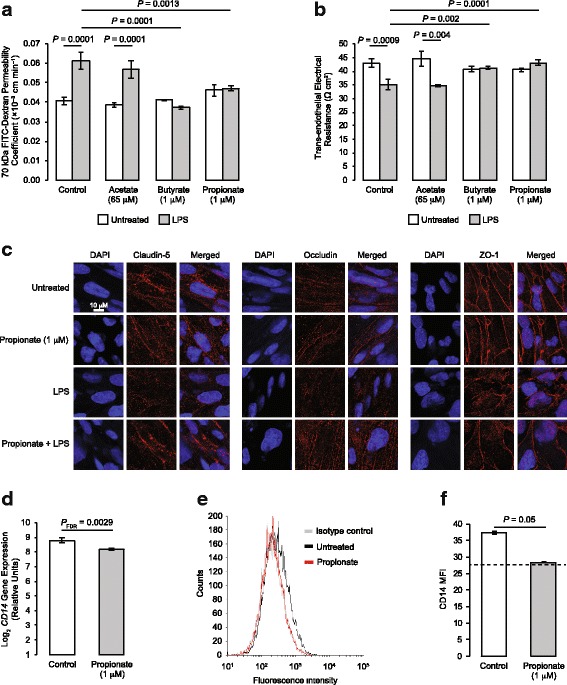Fig. 2.

Protective effects of propionate against LPS-induced barrier disruption. a Assessment of the paracellular permeability of hCMEC/D3 monolayers to 70 kDa FITC–dextran following treatment for 24 h with 65 μM acetate, 1 μM butyrate or 1 μM propionate, with or without inclusion of 50 ng/ml LPS for the last 12 h of incubation; data are mean ± SEM, n = 3 independent experiments. b Trans-endothelial electrical resistance of hCMEC/D3 monolayers following treatment for 24 h with 65 μM acetate, 1 μM butyrate or 1 μM propionate, with or without inclusion of 50 ng/ml LPS for the last 12 h of incubation; data are mean ± SEM, n = 3 independent experiments. c Confocal microscopic analysis of expression of the tight junction components claudin-5, occludin and zona occludens-1 (ZO-1) in hCMEC/D3 cells following treatment for 24 h with 1 μM propionate, with or without inclusion of 50 ng/ml LPS for the last 12 h of incubation. Scale bar (10 μm) applies to all images. Images are representative of at least three independent experiments. d Expression of CD14 mRNA in control and propionate-treated (1 μM; 24 h) hCMEC/D3 cells according to microarray data (data are mean ± SEM, n = 3). e Surface expression of CD14 protein on control and propionate-treated hCMEC/D3 cells (grey line, unstained cells, black line secondary antibody control, red line FFAR3); data are representative of three independent experiments. f Median fluorescence intensity of surface expression of CD14 protein on control and propionate-treated hCMEC/D3 cells; dashed line indicates isotype control fluorescence intensity; data are mean ± SEM, n = 3 independent experiments
